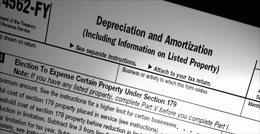BLOG
Economic stimulus implications: Bonus Depreciation recapture is coming

Recently, I came across an article written by Hal Vandiver for the Material Handling Industry of America regarding the current Economic Stimulus Package and its impact on asset-owning businesses. Mr. Vandiver described the initial benefit of this measure very well, including some mathematical analysis of asset purchases that occur in 2008 or 2009. Put simply, the continuation of Bonus Depreciation and increased Section 179 deductions as economic stimulation have a significant impact for companies able to take advantage of these measures. That said, there is a hangover looming in the distance of which these companies should be aware. That hangover is "depreciation recapture" caused by an artificially lower basis than would normally apply to these assets. Clearly, these stimulation measures are a double-edged sword, in the form of immediate increased depreciation expense, yet an artificially lower basis (therefore higher taxes) if these assets are sold before the end of their MACRS recovery lives.
Having myself recently written an article comparing the American Recovery and Reinvestment Act of 2008 to 1031 Exchanges, I thought perhaps an extension of the math used by Mr. Vandiver to include a look at the remaining basis of these assets would demonstrate depreciation recapture and connect the dots between these active economic stimulation measures and Section 1031 Exchanges.
What follows is an analysis outlining the benefits of Section 179, Bonus Depreciation and 1031 Exchanges for MACRS 5-year assets (Mr. Vandiver reviewed 7-year assets; however the principles are the same, and the application of 5-year recovery periods is more common for transportation assets, equipment, aircraft, information systems and many other assets). For calculation of depreciation recapture, I have assumed an 80% residual value for assets sold in year 2 of their recovery periods, and a blended income tax rate of 37%. To understand the implications for any transaction you are contemplating for your business, be sure to contact your tax advisor.
SCENARIO 1: BASELINE - STANDARD DEPRECIATION (pre and post 2008-2009 tax years)
New Machine Purchase - $100,000
Standard MACRS Depreciation (20%) - $20,000
Asset Basis after 1st Year (includes ½ year of 2nd year depreciation*) - $64,000
Selling Price in 2nd Year - $80,000
Gain on Sale - $16,000
Depreciation Recapture (37% Income Tax on Gain) - $5,920
SCENARIO 2: BASELINE WITH BONUS DEPRECIATION (2008-2009 tax years)
New Machine Purchase - $100,000
1st Year Bonus Depreciation (50%) - $50,000
PLUS Standard MACRS Depreciation on Remaining Basis (20% * $50k) - $10,000
Asset Basis after 1st Year (includes ½ year of 2nd year depreciation*) - $32,000
Selling Price in 2nd Year - $80,000
Gain on Sale - $48,000
Depreciation Recapture (37% Income Tax on Gain) - $17,760
SCENARIO 3: BASELINE WITH STANDARD SECTION 179 DEDUCTION (pre and post 2008-2009 tax years)
New Machine Purchase - $400,000
Section 179 Deduction - $128,000
Standard MACRS Depreciation (20% * $272k) - $54,400
Asset Basis after 1st Year (includes ½ year of 2nd year depreciation*) - $174,080
Selling Price in 2nd Year - $320,000
Gain on Sale - $135,920
Depreciation Recapture (37% Income Tax on Gain) - $50,290
SCENARIO 4: BASELINE WITH BONUS AND INCREASED SECTION 179 DEDUCTION (2008-2009 tax years)
New Machine Purchase - $400,000
Section 179 Deduction - $250,000
PLUS Bonus Depreciation (50% * $150k) - $75,000
PLUS Standard MACRS Depreciation (20% * $75k) - $15,000
Asset Basis after 1st Year (includes ½ year of 2nd year depreciation*) - $48,000
Selling Price in 2nd Year - $320,000
Gain on Sale - $272,000
Depreciation Recapture (37% Income Tax on Gain) - $100,640
For each of the above scenarios, the application of Section 1031 Exchange treatment would defer the recognition of gain on sale; therefore the depreciation recapture problem is removed. Assets that take advantage of either of these economic stimulation measures and are sold at any point before the end of their recovery lives will face artificially lower bases, and therefore suffer from larger depreciation recovery issues in the form of higher taxes. Fortunately, these inflated tax payments can be postponed through the utilization of 1031 Exchanges.
While this analysis is intended to demonstrate the depreciation recapture issue, rather than the complete benefit of Section 1031 Exchanges, it is worth noting that at any point during or after an asset's MACRS recovery life, Section 1031 Exchanges can have a significant bottom-line impact until such time as their market-driven residual values become insignificant.
*Assuming the Midyear Convention is utilized for determining remaining basis in these assets, and that the asset has not reached the end of its MACRS depreciable life, these assets will receive an additional depreciation allowance equal to ½ of the allowable depreciation for the year in which they are sold. The MACRS schedule allows a half year of depreciation in the first and last recovery years. Consult your tax advisor to understand the Convention required for your asset types and placed in service dates (i.e. if more than 40% of the MACRS property is placed in service in the last quarter, the Midquarter Convention must be used).
__________
Thanks to Joe Lane for pointing me to this article.
